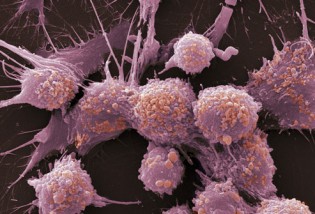Prostate cancer on the rise in Zim

Sifelani Tsiko Senior Writer
The prevalence of prostate cancer among Zimbabwean black men is rising and the growth rate is now several times higher in recent years than it was 20 years ago, according to findings by the Zimbabwe Cancer Registry (ZCR). Mr Eric Chokunonga, the registrar of the Zimbabwe Cancer Registry told participants at a workshop which was organised by the Radiation Protection Authority of Zimbabwe (RPAZ) recently that even though the incidence of Kaposi sarcoma cancers were still relatively high, new trends now show that rectal cancers were now increasing at a faster rate than ever before.
“Rectal cancers are coming up and prostate cancer is on the rise,” he said. “It was not common in Africa but it’s on the rise more like what is happening in most Western countries.”
The registry’s findings were largely based on the incidence rates of different cancers calculated for the black population in Zimbabwe for a 20-year period (1991-2010).
Mr Chokunonga and other oncologists at the workshop said the rise in the incidence of prostate cancer and other cancers in the country were a reflection of the continuing social and lifestyle changes and the wane of the HIV-AIDS epidemic.
The risk of prostate cancer among black Zimbabwean men increased dramatically to 6,4 percent annually and new trends show that prostate cancer has now become the most common cancer of men.
The most common cancers among black men indicate that Kaposi sarcoma incidence are at 20,3 percent and declining in a trend that oncologists say could be largely due to the introduction of life-prolonging drugs – ARVs which have slowed down HIV and Aids deaths.
In addition, statistics among black men also show that the incidence of cancer of the prostate are at 15,5 percent, Non-Hodgkin lymphoma (NHL) 8,9 percent, oesophagus 5,7 percent, eye 5 percent, liver 4,7 percent, Non-Melanoma of skin cancer 4,5 percent, stomach 3,6 percent, lung 3 percent and 2,3 percent for colon cancer.
Mr Chokunonga said a study on the geographical variations of the prevalence of cancer in Zimbabwe was still being carried out and findings would be published soon.
“It is not clear that the use of sexual enhancing drugs or early testing could be a reason for the rise in prostate cancer among black men,” he said. “The kinds of diet we are taking which are increasingly becoming westernised and a combination of sedentary lifestyles is one of the attribution. More studies need to be done to analyse cancer patterns and incidences in Zimbabwe.”
Dr Ntokozo Ndlovu, a radiation oncologist said Kaposi sarcoma cancers were very rare 40 years ago and were largely confined to Jewish people.
“The epidemic HIV-related Kaposi sarcoma has drowned much evidence on Kaposi sarcoma cancers in Zimbabwe,” she said. “Males are now more susceptible to getting Kaposi sarcoma than women. It’s another area that requires further research.”
The overall risk of cancer increased during the period in both sexes, with rates of cervix and prostate cancers showing particularly dramatic increases (3,3 percent and 6,4 percent annually, respectively).
The incidence of cancer of the esophagus, formerly the most common cancer of men, has remained relatively constant, whereas rates of breast and cervix cancers, the most common malignancies of women, have shown significant increases (4,9 percent and 3,3 percent annually, respectively).
The incidence of Kaposi sarcoma increased to a maximum around 1998-2000 and then declined in all age groups, and in both sexes.
The most common cancers among black women included cervix cancer at 32,2 percent, breast 12 percent, Kaposi sarcoma 8,3 percent, eye 5 percent, Non-Hodgkin lymphoma 4,3 percent, easophagus 3,4 percent, Non-Melanoma of skin cancer 3,3 percent, ovary 2,6, stomach 2,1 and corpus uteri 2 percent.
Incidence of cancer among non-black men indicate that Non-melanoma skin cancer at 55,5 percent as the biggest killer while prostate is second at 10,1 percent, colon 5,3 percent, NHL 4,5 percent, lung 3,2 percent, Melanoma skin cancer 3,2 percent, bladder 2,8 percent, rectum 2,4 percent, stomach 1,6 percent and eosophagus 1,2 percent.
For non-black women, Non-Melanoma skin cancer is also relatively high at 41,7 percent followed by breast cancer at 18,1 percent, cervix uteri 6,9 percent, colon 4,6 percent, rectum 4,6 percent, ovary 3,2 percent, lung 2,3 percent, Melanoma skin cancer 1,9 percent, bladder 1,9 percent and NHL 1,9 percent.
When combined, the most common cancer among all Zimbabwean men is Kaposi sarcoma at 17,6 percent followed by prostate at 14,8 percent and Non – Melanoma skin cancer at 11,3 percent while for all Zimbabwean women, cervix cancer remains the biggest killer at 30,2 percent, breast 12,4 percent, Kaposi sarcoma 7,7 percent and Non-Melanoma skin cancer 6,4 percent.
Oncologists say cancer control in Zimbabwe, as elsewhere in sub-Saharan Africa, involves meeting the challenge of emerging cancers associated with westernisation of lifestyles (large bowel, breast and prostate), while the incidence of cancers associated with poverty and infection (liver, cervix and esophagus) shows little decline, and the residual burden of the AIDS-associated cancers remains significant.
The Zimbabwe Cancer Registry says the most common cancers among all boys (paediatrics) include Leukaemia (cancer of the blood) at 17,7 percent, Retinoblastoma (eye cancer) 13,3 percent, Kaposi sarcoma 12,2 percent and Wilms Tumour (cancer of the kidney).
Among all Zimbabwean girls, Kidney cancer is relatively high at 22,6 percent followed by Retinoblastoma at 13,1 percent, brain and nervous system cancer 10,7 percent, Kaposi sarcoma 9,5 percent and Leukaemia 9,5 percent.
Mr Chokunonga said ZCR uses both active and passive methods of case-finding which includes staff visits to institutions in the healthcare delivery system to register cases while some institutions reported their cases voluntarily to the ZCR.
“The Zimbabwe Cancer Registry is one of the best in the world in terms of high quality data in captures and consistence,” he said. “Very few countries in the region have quality data. In Sub-Saharan Africa there are four countries that produce cancer registers and Zimbabwe is among them.”
Sources of information for the registry included Government referral hospitals and private hospitals in Harare and Bulawayo, public and private pathology laboratories, radiotherapy centres in Harare and Bulawayo, the Death Registry and the Bulawayo Cancer Registry.
The ZCR has over the years provided technical support to registries in sub-Saharan Africa on behalf of the International Agency for Research on Cancer, World Health Organisation and the International Atomic Energy Agency.
ZCR results have been published in 4 successive volumes of Cancer Incidence in 5 Continents (Volumes 7-10).
People of all races are equally at risk of getting various types of cancers but oncologists say incidence rates differ mainly due to differences in medical care access, screening, registry quality, genetic diversity, and Westernisation.
They say incidence rates in Africa were likely to continue rising with improving economies and increasing Westernisation, warranting the need for more high-quality population-based registration to monitor cancer incidence in Africa.
Oncologists further say that cancer kills more people worldwide than AIDS, tuberculosis, and malaria together.
Africa, they say, needs a strategy for vaccination, screening, treatment and awareness to fight the rising cases of cancer on the continent.
“Cancer is slowly receiving attention in Africa, but other diseases such as AIDS still absorb much of the funding,” said a Harare-based oncologist. “We need to start spending more on cancer research and treatment.
“Many of the strategies aimed at preventing HIV could also help in cancer prevention too.”











Comments